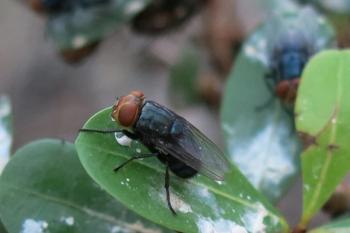
Every breath you take
What is your number? We all have numbers that are important to us as individuals-our social security number, our telephone number, maybe even our bed's sleep number. But there should be another number that is important to you, too, and that is an AQI number. The Air Quality Index (AQI) is a means of reporting daily air quality, and it is a measure of how clean or polluted air in a specific location is. The AQI number directly relates to the possible health and environmental effects of air, as well as the calculated health risks within a few hours to days after breathing it.
What is your number? We all have numbers that are important to us as individuals—our social security number, our telephone number, maybe even our bed's sleep number. But there should be another number that is important to you, too, and that is an AQI number. The Air Quality Index (AQI) is a means of reporting daily air quality, and it is a measure of how clean or polluted air in a specific location is. The AQI number directly relates to the possible health and environmental effects of air, as well as the calculated health risks within a few hours to days after breathing it.
Equine veterinarians commonly are called upon to diagnose and treat horses with respiratory problems, and those concerns are frequent especially during the hazy, hot, humid months of summer. Studies done in 2000 actually show respiratory problems to be second only to lameness as a major cause of lost training time among horses used for racing or performance. Many respiratory problems in horses and humans are very closely linked to the quality of inhaled air and to the amount and types of allergens and pollutants in that air. Conditions such as chronic obstructive pulmonary disease (COPD), bronchitis, and other asthma-related problems that are air-quality sensitive also are rarely curable. Veterinarians stress management of these horses with their clients, and management usually involves both medical and environmental means. Horses suffering from heaves are commonly treated with anti-inflammatories, antihistamines, steroids, bronchodilators and various inhalant compounds. Owners of these horses are encouraged to rest them when the weather is bad, to wet their hay, to use fans and reduced-dust bedding and other measures designed to improve air quality. Often, however, the actual quality of that air and the nature of the impurities in it are unknown. So it is difficult for veterinarians to identify those horses that react with fungal spores from those that react to dust or ozone. DNA-based allergy testing can help in this identification process, but we still need to know what is in the air that we all breathe.
Particulate matter can be large enough and dark enough to be seen, such as in dust, dirt, soot and smoke, or it can be so small that it can be detected only by electron microscope.
This is where AQI comes in and where veterinarians might be able to help their clients take a giant step toward successful management of horses with allergic inflammatory responses. AQI is calculated by the Environmental Protection Agency (EPA) focusing on the five major air pollutants regulated by the Clean Air Act. These pollutants are ground-level ozone, particulate matter, carbon monoxide, sulfur dioxide and nitrogen dioxide. Research has shown that these pollutants represent the greatest dangers to health, and the EPA has set national air-quality standards for them. The EPA makes measurements and calculations for all of these pollutants, and this information is then factored into an AQI number for a given location within the United States. A value of 100 is the national standard. Values below this number generally are thought to be satisfactory. Values of 0-50 are considered good, and values of 50-100 are moderate, meaning that only those animals and humans with pre-existing respiratory problems might experience health concerns. Values from 101 to 150 are considered unhealthy for sensitive individuals, and values from 150 to 200 are unhealthy for everyone. Levels beyond this are labeled very unhealthy and then hazardous and correspond to serious health concerns and emergency conditions.
The five major air pollutants merit a closer look because these different respiratory irritants are found in different locations across the country, and they seem to affect individuals differently. David Hurley, a Ph.D. microbiologist working at the University of Georgia College of Veterinary Medicine and exploring the interaction of various pollutant particles on respiratory health, points out that some horses, just like some humans, might have fungal trigger levels while others can have ozone trigger levels. These would be the levels of various irritants that initiate an inflammatory response in a specific individual.
"Research in various human pediatric medical departments is currently aimed at identifying the particular levels of various irritants that cause these responses," Dr. Hurley says. "But equine medicine is not quite there yet."
Encephalitis hits 3 states
Knowing more about the specific pollutants will help isolate and identify their effects.
Ozone (O3) is a gas emitted into the air and is created at ground level by a chemical reaction between nitrogen oxides and volatile organic compounds in the presence of heat and sunlight. Motor vehicle exhaust, emissions from industrial plants, chemical solvents and gasoline vapors are the chief sources that produce ozone. Ground-level ozone and ozone occurring in the atmosphere have the same chemical composition. Ozone that forms 10-30 miles above the earth's surface forms a protective layer to block the sun's harmful rays. This is considered good ozone while the same compound formed at ground level can irritate lung tissue and cause inflammation. Even low levels can cause aggravated asthma, reduced lung capacity and decrease exercise tolerance and increased susceptibility to infection. Repeated exposure can cause scaring of the lung tissue leading to permanent damage. This is considered bad ozone. Because ozone formation requires heat and sunlight, it is known as summertime irritant and commonly is found in high levels in urban areas. But ozone carries well in wind, and rural areas many hundreds of miles removed from the initial site of formation can be affected seriously.
Particulate matter (PM) is the term used for particles found in the air. These particles can be large enough and dark enough to be seen—as in dust, dirt, soot and smoke—or they can be so small that they can be detected only by electron microscope. Some particles come from engines emissions, factories, dust and dirt from construction sites, tilled fields, horse arenas, unpaved roads and from burning wood. Others come from chemical reactions from fuel combustion. These particles also can damage lung tissue and initiate inflammatory responses in sensitive individuals at even low levels. PM also is likely to cause significant throat irritation resulting in coughing, and it is the major cause for eye irritation and excessive ocular discharge, redness and irritation.
Carbon monoxide (CO) is primarily the result of burning vehicle fuels and, as such, is produced in large quantities in urban areas. CO causes intense irritation to lung tissue and can be lethal in high concentrations. Nitrogen dioxide (NO2) occurs when fuel is burned at high temperatures and is mainly produced by vehicles, electric utilities, and industrial combustion processes. Sulfur dioxide (SO2) is produced mainly by coal-burning electric utilities at a rate of nearly 13 million tons per year. In the air, the SO2 reacts with other chemicals to form small sulfur particles that gather in the lungs and cause tissue damage.
Since all of these pollutants can cause lung damage it is important to know how much of these irritants is in the air where you and your clients' horses live. The EPA maintains a Web site that can provide this information and will help you counsel your clients on management of these sensitive horses. By accessing
"Eventually it is hoped that research will be able to identify the particular pattern of allergic triggers for individuals," Hurley says. "Products such as leukotrine inhibitors can help to stop those triggers form causing these severe allergic responses."
Until that point, using the EPA data to find the AQI number that works best for affected horses may be the best management plan available.
Newsletter
From exam room tips to practice management insights, get trusted veterinary news delivered straight to your inbox—subscribe to dvm360.






